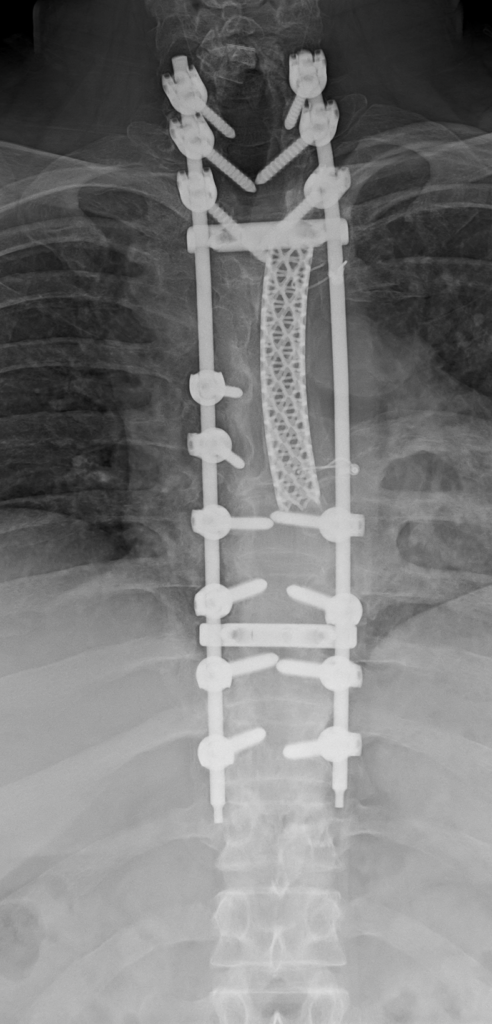 During a High Altitude-Low Opening (HALO) training exercise, Renn underwent a horrific accident where he plummeted straight into the earth at 120 mph after a teammate flew through his parachute and knocked Renn unconscious.
During a High Altitude-Low Opening (HALO) training exercise, Renn underwent a horrific accident where he plummeted straight into the earth at 120 mph after a teammate flew through his parachute and knocked Renn unconscious.
Two weeks later, Renn woke up in a military hospital. He couldn’t move. Grateful to be alive, Renn, the hard-charging, determined, constantly active, and relentless exerciser, always pushing himself to the max of physical limits, could barely move a muscle, let alone walk.
All of that physical drive and constant working out had saved Renn. Without his incredibly well-developed muscles around his bones, his spine would have been crushed. Instead, it was just broken in numerous places.
The military hospital doctors worked wonders on his spine, improvising as they constantly have to do. They were able to at least preserve his fundamental physical structure, not that Renn could do much with it. He could barely move and when he did the pain was excruciating.
Renn was eventually able to return to duty, sitting behind a desk for as long as he could stand the pain. He refused the more powerful painkillers and settled for the over-the-counter variety, like Motrin, instead of the unquestionably more effective and more dangerous opiates.
After his recovery from surgery, Renn spent most of the time sitting on the couch at home, wincing in pain and incapable of movement. His biggest regret was that he couldn’t help his son as he was practicing his military preparation skills, like land navigation. He also missed his other family, the ones still in combat, fighting together.
Renn became an onlooker rather than a participant in his family life. And the man who previously had been the symbol of physical fitness now degenerated into an out-of-shape, overweight and depressed version of his former self. He was also two inches shorter, had seven pounds of metal holding him together, and suffered from traumatic brain injury. He sorely missed his life with his friends on the front line.
And that was how Renn lived for well over a decade. He tried to take up some physical activity but whenever he did, the pain became unbearable and it was simply too much even for this hardened warrior. Sure, he was grateful to be alive, but his life was in complete contrast to, and unrecognizable from, his former self. He was like a singer who had lost his voice; it wasn’t just the activity that had been lost but also its meaning and purpose. He was a different person.
Renn periodically had to report to Landstuhl where doctors could monitor his progress, take x-rays and service the metallic parts that were holding him together. During one of these visits, almost 14 years after his disastrous fall from space, one of his doctors told him about a new pain clinic that had opened in the hospital compound. Renn didn’t need a second invitation and made an appointment.
“When I first went to the clinic, I thought the program was going to get rid of my pain,” Renn remembers. “But Jeff soon dispelled that illusion. However, he told me that there were now ways of reducing the pain, and more importantly, return to greater mobility and healthier lifestyle.”
I told Renn about the multi-faceted program that would help do the one critical thing—keep moving.
“I started doing some yoga. Previously I had been very skeptical about techniques like yoga but I was able to do it. And despite all the metal I had in my spine I didn’t feel as much pain as I had anticipated. For the first time since my accident, I started to feel some hope.”
Over the next few weeks, I explained to Renn that movement was key. That sitting in the recliner all day was only making things worse and that while he would still have pain, he could learn to suppress it, change his lifestyle and become a whole lot healthier.
“Jeff can motivate anybody but once I saw and felt what I could now do, I wasn’t going to stop,” Renn said.
Within a few short weeks, Renn was back at the gym. He found the elliptical and the rowing machines the ideal pieces of equipment and was getting more and more active, a drastic contrast to the totally sedentary person he had been for the last 14 years.
Within a few months, Renn was back to being active, reveling in reducing the pain and feeling more active and useful. He could once again actively participate in family life, like going bike riding with his children and doing chores around the house.
The return of movement and activity brought about a drastic improvement in his health. He lost weight and his vitals improved significantly.
“My heart rate and blood pressure are back to where they were at the peak of my fitness,” Renn said. “My mental and physical improvement have been incredible. Going to Jeff and the pain clinic woke my ass back up, literally and metaphorically. I felt like an old man for a very long time but now I feel as if I have my health and life back. My only regret was that I didn’t do this sooner.”
“2001, I was an extremely active individual. I tried to get right back into being fit but the pain was too much. I do not take pain medications because I don’t like the idea of being constantly medicated. After my mandatory career MOS (Military Occupation Specialty) change, I would do very little physical activity, almost to the point of being lethargic going through MRP (MRP is what gave birth to the program used at The FIX). I really regained my confidence in working out and got over the fear that activity would aggravate my hardware. I still have the pain, but I am so much more active today because of the MRP. I am even able to run on the treadmill for up to three minutes now. Now I have the mindset that I feel the same pain with activity that I did with doing none. I only wish that this program was available to me years ago. I play and do so much more now with my youngest daughter, sometimes she can’t take all of the energy I have. Thank you for the opportunity to attend this program. My wife and kids thank you as well!”


